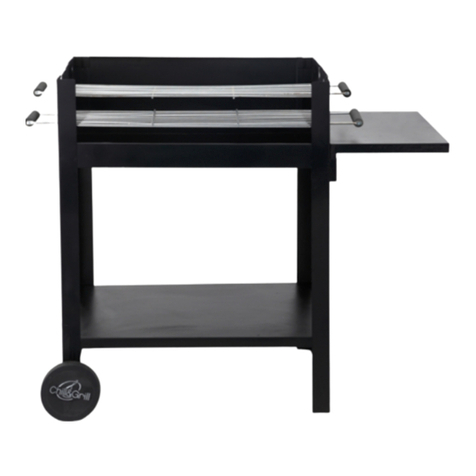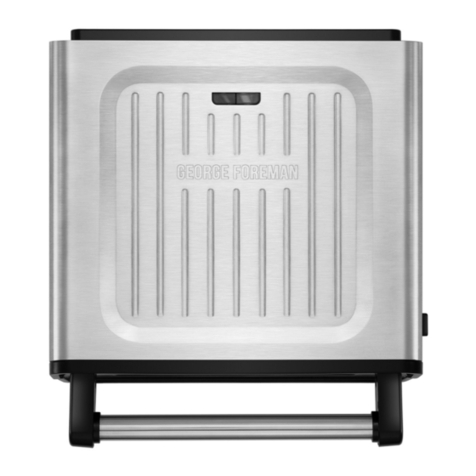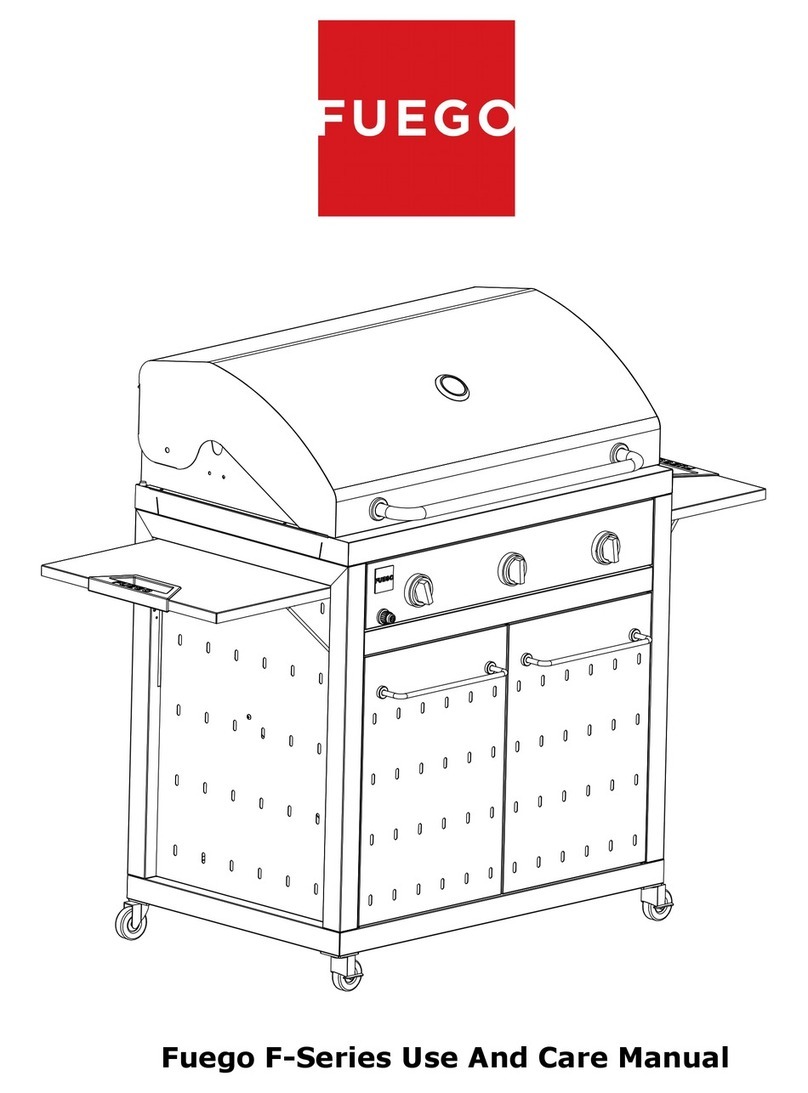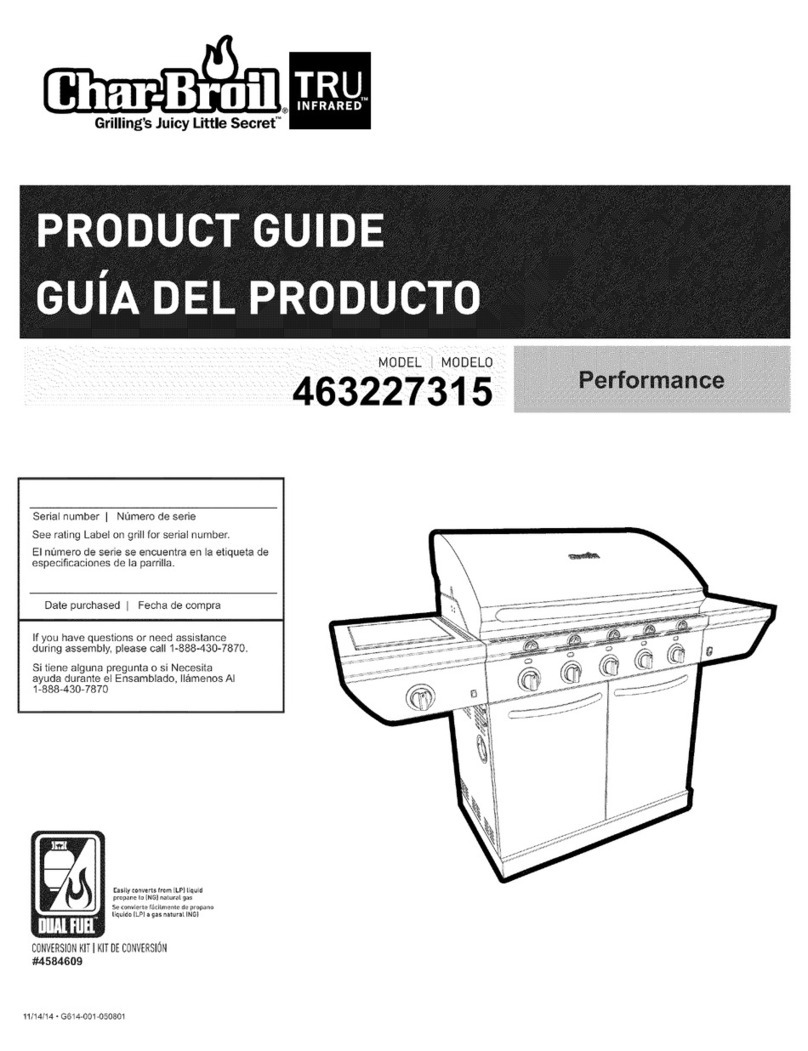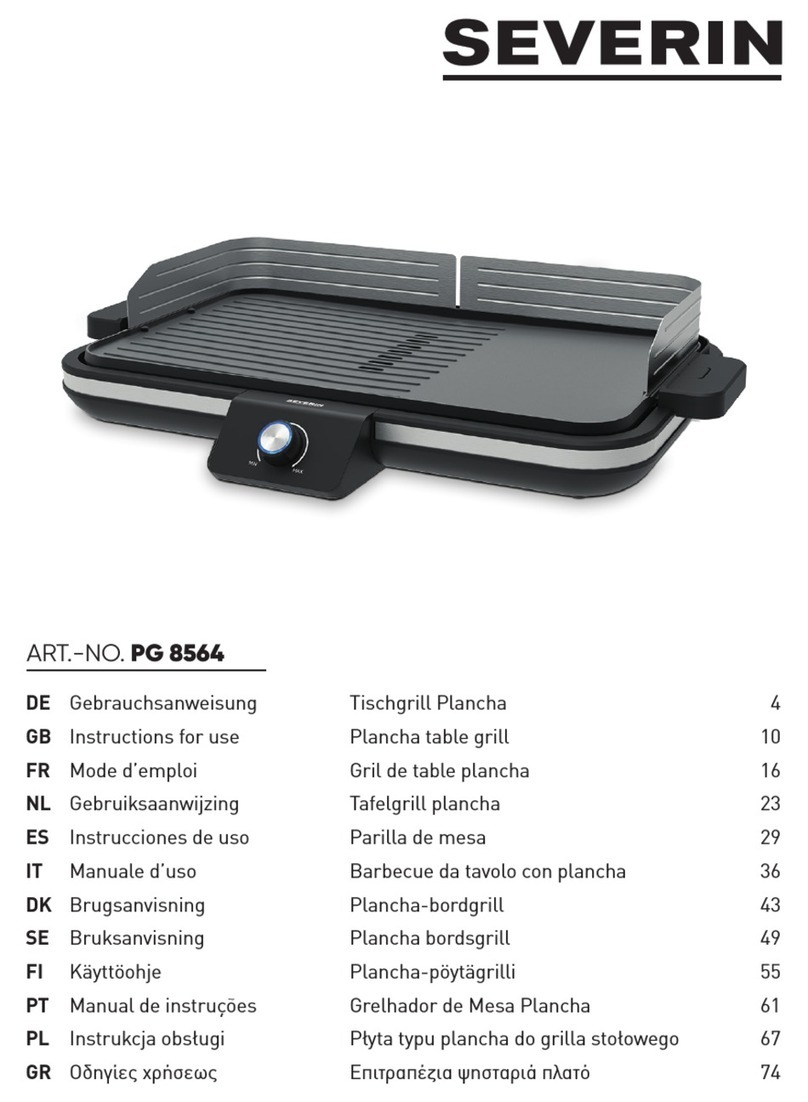grillsteram GSZIGGYG User manual

•
•
•
•
•
FOR YOUR SAFETY
If you smell gas:
1. Shut off gas to the appliance.
2. Extinguish any open flame.
3. Open barbecue lid or hood.
4. If odour continues, discontinue use and contact
your local dealer.
FOR YOUR SAFETY
1. Do not store or use petrol or other flammable
vapours or liquids in the vicinity of this or any
other appliance.
2. A gas bottle not connected for use must not be
stored in the vicinity of this or any other
appliance.
0052-13
Assembly and operating instructions for ZIGGY gas barbecues
GSZIGGYG, GSZIGGYR, GSZIGGYBL
Pictures are not to scale.
Specifications subject to change
without prior notice.
For outdoor use only. Not for commercial use.
Read instructions before using the appliance. Failure to follow instructions could
result in death, serious bodily injury, and/or property loss.
Warning: accessible parts may be very hot. Keep young children and pets away.
Do not move the appliance during use.
• Retain these instructions for future reference.
• Leak test regularly, and whenever the gas bottle is removed or replaced. Check that the
the hose connections are tight and leak test each time you reconnect the gas bottle.
Any modification of the appliance, misuse, or failure to follow the instructions may be
dangerous and will invalidate your warranty. This does not effect your statutory rights.

WARNING INFORMATION
- Read this Operating Manual before use
- Ensure there is adequate clearance away from flammable materials
- This bbq is only to be used outdoors - NEVER take a lit BBQ into a tent,
caravan or cabin
- Do not allow children to operate the bbq
- Accessible parts may be very hot, keep children away
- Any modification of this bbq may be dangerous
- Do not move this bbq during use
- When you have finished cooking, turn off the gas cylinder before you turn off
the BBQ controls - this means any gas in the pipeline will be used up
- Parts sealed by the manufacturer or their agent must not be
manipulated by the user
- BBQ specifications can be found on the data label attached on the
side panel of the bbq frame
- Do not store or use petrol or other flammable vapours and liquids
near the bbq
- Do not store empty or full spare gas cylinders under or near the bbq
- Keep the gas hose and any electrical cord away from hot surfaces
- Avoid unnecessary twisting of the gas hose
- Visually inspect hose prior to each use for cuts, cracks, excessive
wear or other damage
- The hose must be replaced if damaged and when National Conditions
require it
- Never light the bbq with the hood or lid closed
- Never lean over the cooking surface whilst lighting the bbq
- Use bbq tools with heat proof handles or good quality insulated oven
mitts when operating bbq
- Never alter or modify the regulator or gas supply assembly
LOCATION OF YOUR BBQ
IMPORTANT - BBQS MUST BE INSTALLED IN ACCORDANCE WITH
THE MANUFACTURER’S INSTALLATION INSTRUCTIONS, LOCAL
GAS FITTING REGULATIONS AND MUNICIPAL BUILDING CODES.
Think carefully when deciding on a location where you are to use your
bbq. The bbq must not be installed under or on any combustible
material and must be a level surface.
Minimum clearance from any combustible materials on ALL sides is
250mm (10”). Minimum clearance from any combustible material from
the TOP of the bbq is 1500mm (59”). (Fig. 1)
- Not to be used in garages, porches, breezeways, sheds, or other
enclosed areas
- Not to be used on recreational vehicles
- Do not obstruct flow of combustion and vetilation air around the bbq
250mm
Minimum
250mm
Minimum
250mm
Minimum
250mm
Minimum
1500mm Minimum
CONNECTING THE GAS CYLINDER
There are two different types of gas that can be used on your gas bbq
depending on where you live, that being either butane or propane gas.
Both are supplied in gas cylinders. The connection between the gas
cylinder and the bbq is made with a regulator. (Fig. 2)
It is important that you use the correct regulator for the particular type
of gas you purchase. See your local gas dealer for information on
purchasing the correct regulator. Never operate this bbq without a gas
regulator.
THE HOSE AND REGULATOR ASSEMBLY (Fig. 3)
- Must be suitable for liquefied petroleum gas (LPG)
- Must withstand the above pressures
- Must not exceed 1000mm (39”) in length
- The bbq is supplied with a screw on hose that is suitable for direct
connection of a suitable regulator
- Before connecting inspect the hose, its fittings and rubber seals. If
there is any sign of cracking, splitting or wear, have the hose
replaced
- While in use, keep the hose unobstructed and free of kinks and
twisting
(Fig. 1)
(Fig. 2)
(Fig. 3)
NOTE: Hose and Regulator
picture for reference only.
The following gas supply pressures are a guide only:
0052-13
(5.2kw)
ITEM:BG1320C2&BG1320D2
G30 – 378 g/h,G31 – 372 g/h;
“Use outdoors only.”
“Read the instructions before using the appliance.”
“WARNING: accessible parts may be very hot. Keep young children away.”
Country of destination Category/ies Type of gas Supply pressure (mbar)
PL I3B/P 7313G/03G
EE - LT - LV - CY - MT
CZ- FR - BE - LU - GB
IE - LT - SK - GR - PT
ES - IT - CH
50
AT - DE - CH I3B/P G30/G31
I3+ 73/03-8213G/03G
FI - NO - SE - DK - NL
RO - HU -SK - SI - SE
I3B/P 0313G/03G
GB I3+
G30/G31 28-30/
37mbar
ZIGGY

Quantity varies according to model purchased. Specifications subject to change without prior notice.
Exploded View
Parts List
1. LID
2. LID HANDLE
LID PIN (2)
LID HANDLE PAD (2)
THERMOMETER
LOGO
HAIR PIN (2)
BODY
BODY SUP (2)
KNOB ASSEM (2)
KNOB SEAT(2)
CONTROL PANEL
GRILLSTREAM COOKING GRILLS (4)
LEFT U BURNER ASSEM
RIGHT U BURNER ASSEM
GAS TANK ISOLATION
OIL CUP
PF PAD (8)
MAIN VALVE
BODY SUP BEAM (2)
LEAD FIRE BOX
ALUMINIUM FOIL CUP
REGULATOR (IF SUPPLIED)
VALVE PIPE FIXED
3.
4.
5.
6.
7.
8.
9.
10.
11.
12.
13.
14.
15.
16.
17.
18.
19.
20.
21.
22.
23.
24.
IGNITION STICK ASSEM
25.
SIDE SHELF (2)
26.
GRILL RISER
27.
FLAME TAMER
28.
1
2
3
8
13
14
11
18
9
10
12
15
16
17
20
19
21
22
25
26 24
6
23
28
4
5
7
Pre-Assembled Component
ZIGGY
27

ZIGGY
Assembly
1
2
34
Attach part (26) Insert part (13, 28, 27)
**Grill riser MUST only be positioned at
the front of the BBQ**
Attach (17,22) Attach (25)

ZIGGY
ASSEMBLY IS NOW COMPLETE.
PROCEED TO THE NEXT PAGE FOR INSTRUCTIONS ON OPERATION AND MAINTENANCE
ALL JOINTS AND CONNECTIONS MUST NOW BE LEAK TESTED BEFORE USING THE BARBECUE.
Leak test regularly, and whenever the BBQ is moved or the gas bottle is removed or replaced.
LEAK TESTING
Always perform a leak test in a well-ventilated area.
Step 1 - Confirm all control knobs are in the position.
Step 2 - Detach the barbecue control panel located across the front of the barbecue body by pulling off the
control knobs and removing the control panel retaining screws.
Step 3 - Turn the gas on / open the gas control valve on the gas bottle or regulator.
Step 4 - Check for leaks by brushing a solution of ½ water and ½ liquid detergent / soap over all the gas
system joints, including all valve connections, hose connections, and regulator connections.
Step 5 - NEVER USE AN OPEN FLAME to test for leaks at any time.
Step 6 - If bubbles form over any of the joints there is a leak
• Turn off the gas supply at the gas bottle
• Retighten all joints
• Repeat test
• If bubbles form again do not use the barbecue and contact your local distributor for assistance.
Always wipe the mixed solution (½ water and ½ liquid detergent / soap) from all joints and connections
after leak testing.

ZIGGY
6. Important Information
Please read these instructions carefully before
assembly and use of your barbecue.
Retain these instructions for future reference.
This product is for outdoors use only. Do not use
indoors.
Do not use the barbecue or store gas bottles below
ground level. LP gas is heavier than air so if a leak
occurs the gas will collect at a low level and could
ignite in the presence of a flame or spark.
For use with LPG bottled gas only. A suitable
regulator must be used for butane, propane or mixes.
Remove plastic wrap from any part before lighting.
Do not use within 1m of any flammable structure or
surface. Do not use under any combustible surface.
LP gas bottles should never be placed directly
underneath the barbecue.
LP gas bottles should never be stored or used laid
on their side, in the horizontal position. A leak would
be very serious and liquid could enter the gas line
with serious result.
Never store gas bottles indoors.
Open the barbecue hood or lid before lighting.
Once lit, do not move the barbecue until it has
completely cooled, after use.
This barbecue must not be left unattended when lit.
The hood or lid handle can become very hot. Grip
only the centre of the handle. Always use oven
gloves when cooking or carrying out any adjustments
to the barbecue.
Use purpose designed barbecue tools with long, heat
resistant handles.
Use caution when opening the hood or lid, as hot
steam inside is released upon opening.
Parts of this barbecue become very hot – care must
be taken, especially when children, elderly people,
and animals are present.
When you have finished cooking, turn off the gas
cylinder before you turn off the BBQ controls to ensure
any gas in the pipeline is used up.
Never cover a barbecue until it has completely
cooled.
Use this barbecue only on a stable, flat surface.
Before you use your barbecue, perform a leak test.
This is the only safe and sure way to detect any gas
leaking from joints and connections of the barbecue
after assembly.
Leak test regularly, and whenever the BBQ is moved
or the gas bottle is removed or replaced.
Do not store flammable materials near this barbecue.
Do not use aerosols near this barbecue.
Failure to follow the manual’s instructions could
result in serious injury or damage.
Modification of the barbecue may be dangerous, is
not permitted and will nullify any warranty.
If you have any queries regarding these instructions,
contact your local dealer.
We suggest to use boiler of diameter 160~220mm to
match this BBQ.
7. Gas, Regulator and Hose
This barbecue can use either propane or butane or
propane / butane mixed LPG (liquid petroleum gas)
bottled gas. Propane bottles, will supply gas all year
round, even on cold winter days. Butane bottles will
supply sufficient gas in summer, but it may affect the
performance of the barbecue and restrict the heat output
available from the burners, particularly once the gas
temperature starts to fall below +10°C. A spanner may
be required to change gas bottles. Check that you have
the correct gas bottle and regulator for your barbecue.
Ensure that the gas bottle is placed correctly in the gas
bottle holder provided (holder may not suit all gas bottles).
• The hose should hang freely with no bends, twisting,
tension, folds, or kinks that could obstruct free flow of
gas. Always inspect the hose for cuts, cracks, or
excessive wear before use.
• Apart from the connection point, no part of the hose
should touch any hot barbecue parts. If the hose
shows any sign of damage it must be replaced with a
hose suitable for use with LP gas which meets the
national standards for the country of use.
• The length of hose should not exceed 1.5 metres.
N.B.-The date on the orange hose (if supplied) is the
date of manufacture, not the expiry date.
YOU MUST HAVE THE PROPER REGULATOR AND
BOTTLE IN ORDER FOR THE BARBECUE TO
OPERATE SAFELY AND EFFICIENTLY. USE OF AN
INCORRECT OR FAULTY REGULATOR IS
DANGEROUS AND WILL INVALIDATE ANY
WARRANTY. Please consult your local gas dealer for
the most suitable gas bottles and regulators.
8. Installation
8.1. Selecting a Location
This barbecue is for outdoor use only and should be
placed in a well-ventilated area, and on a safe and even
surface. Never place your barbecue below ground level.
Take care to ensure that it is not placed UNDER any
combustible surface. The sides of the barbecue should
NEVER be closer than 1 metre from any combustible
surface, including trees and fences and make sure that
there are no heat sources near the barbecue (cigarettes,
open flames, spark etc.). Keep this barbecue away from
any flammable materials!
8.2. Precautions
Do not obstruct any ventilation openings in the barbecue
body.
Position the gas bottle on level ground next to the
barbecue and safely away from any source of heat.
Should you need to install or change the gas bottle,
confirm that the barbecue is switched off, and that there
are no sources of ignition (cigarettes, open flame,
sparks, etc.) near before proceeding.
8.3. Connecting a Gas Hose to the Barbecue
Connect the gas hose to the gas rail inlet on the left
hand side of the barbecue using a spanner. Do not
overtighten. Do not
use any sealing tape, paste or liquid
on the connection.
8.4. Fixing a Regulator to the Gas Bottle
Confirm all barbecue control knobs are in the off
position. Connect the regulator to the gas bottle
according to your regulator and bottle dealer’s
instructions.

ZIGGY
9. Operation
9.1. Warnings
Before proceeding, make certain that you understand
the IMPORTANT INFORMATION section of this
manual.
Your barbecue is not designed to be used with more
than 50% of the cooking area as a solid plate — this
includes baking dishes. Full coverage will cause
excessive build-up of heat and damage the
barbecue. This is not covered by warranty.
9.2. Preparation Before Cooking
To prevent foods from sticking to the cooking surface,
please use a long handled brush to apply a light coat
of cooking or vegetable oil before each barbecuing
session. (Note: When cooking for the first time, paint
colours may change slightly as a result. This is normal
and should be expected.)
9.3. Lighting the Barbecue
• Open the barbecue hood or lid before lighting. Never
light your barbecue with the hood or lid closed.
• Ensure all knobs are in the position. Open the gas
control valve on the gas bottle or regulator.
• Flame Thrower Ignition:This ignition system works by
throwing a flame to the side of the burner to light it.
Push the knob in and turn anticlockwise to the
position. Hold the knob in until the burner ignites.
You may need to push and turn the knob several times
before ignition.
• Ignite any of the remaining burners in any order, as
needed. Confirm each burner is alight before igniting
another burner.
• If burner fails to ignite after following above
procedure, turn all the knobs to the position.
Close the gas valve on the gas bottle. Wait 5
minutes. Reattempt all of the above steps. If the
barbecue still fails to light, please refer to the manual
ignition instructions below.
• After ignition, turn the burners to the position for
3-5 minutes in order to pre-heat the barbecue. This
should be done before each cooking session. The
hood or lid should be open during preheating.
• After completion of preheating, turn the burner to the
position for best cooking results.
9.4. Manual Ignition Instructions
• Open the barbecue hood or lid before lighting. Never
light your barbecue with the hood or lid closed.
• Ensure all knobs are in the position. Open the gas
control valve on the gas bottle or regulator.
• Insert a lit match (secured with the lighting rod
provided) into the barbecue body and place near the
burner you wish to light.
• Push and turn the control knob of the burner you
wish to light anti-clockwise to the position,
taking care to protect yourself from the flames.
9.5. Grill Cooking
The burners heat up the flame tamer underneath
the grill, which in turn heats the food on the grill.
The subsequent rising smoke bastes the food, as it
travels upwards, imparting that unique barbecued
flavour.
9.6. Roasting Hood Cooking
Barbecues equipped with a roasting hood give the
option to form an ‘oven’ for roasting or baking food, such
as joints of meat or whole chickens, etc. More even
cooking of food will actually be achieved by using the
barbecue with the hood down. However, this should
only be done with the burners on low.
For best results, place the food you wish to bake or
roast on a metal baking tray and set it on one side of the
cooking grill.
When roasting, turn the burner to a LOW to MEDIUM
position.
Close the hood to cook the food ‘indirectly’. Avoid lifting
the hood unnecessarily as heat is lost every time the
hood is opened. If the hood is opened during cooking
please allow extra time for the barbecue to regain its
temperature and complete the cooking. Use the
temperature gauge (if applicable) to monitor the heat of
the barbecue.
If the internal heat becomes too high, turn the burners
down to the low position. It is not necessary or advisable
to have all of the burners on high when the hood is
closed.
DO NOT ALLOW YOUR BARBECUE TO OVERHEAT.
Take care when opening the hood as hot steam can be
released on opening.
9.7. Warming Rack (where supplied)
Warming racks are a convenient way to keep cooked
food warm or to warm items such as bread rolls. It is
advisable to place food (particularly fatty foods) to the
front of the warming rack to avoid the possibility of juices
and fat running down the back of your barbecue. Always
check that your warming rack is properly fitted before
use.
9.8.In the event of a fat fire:
• If safe to do so, turn all control knobs to the ‘off’
position.
• Turn off the gas supply at the gas bottle.
• Keep everyone at a safe distance from the barbecue
and wait until the fire has burnt out.
• Do not close the hood or lid of the barbecue.
• NEVER DOUSE A BARBECUE WITH WATER. IF
AN EXTINGUISHER IS USED, IT SHOULD BE A
POWDER TYPE.
• DO NOT REMOVE THE GREASE CUP.
• If the fire does not seem to be abating or appears to
be worsening, contact your local Fire Brigade for
assistance.
9.9. End of Cooking Session
After each cooking session, turn the barbecue burners
to the “high” position and burn for 5 minutes. This
procedure will burn off cooking residue, thus making
cleaning easier. Make sure the hood or lid is open
during this process.
9.10. Turning Off Your Barbecue
When you have finished using your barbecue, turn all
the control valves fully clockwise to the “Off” position,
then switch off the gas supply at the bottle.
Wait until the barbecue is sufficiently cool before closing
its hood or lid.

ZIGGY
10. Care and Maintenance
Regularly clean your barbecue between uses and
especially after extended periods of storage. Ensure the
barbecue and its components are sufficiently cool before
cleaning. Do not leave the barbecue exposed to outside
weather conditions or stored in damp, moist areas.
Never handle hot parts with unprotected hands.
Never douse the barbecue with water when its
surfaces are hot.
In order to extend the life and maintain the condition of
your barbecue, we strongly recommend that the unit be
covered when left outside for any length of time,
especially during the winter months.
Even when your barbecue is covered for its protection, it
must be inspected on a regular basis as damp or
condensation can form which may result in damage to
the barbecue. It may be necessary to dry the barbecue
and the inside of the cover. It is possible for mould to
grow on any fat remaining on parts of the barbecue.
This should be cleaned off smooth surfaces with hot
soapy water.
Any rust that is found that does not come into contact
with the food should be treated with a rust inhibitor and
painted with barbecue paint or a heat resistant paint.
A chrome cleaner may be used on chrome parts if
required. To prevent rusting, wipe chrome plated
warming racks etc. with cooking oil after rinsing and
drying.
10.1. Cooking Surfaces & Warming Rack
When the barbecue has cooled, clean with hot soapy
water.
Do not use scouring
pads or powders as they
can permanently damage the finish. Rinse well and
dry thoroughly. Due to the weight of the cooking surfaces,
we do not recommend cleaning in a dishwasher.
10.2. Burner
Your burner has been preset for optimal flame
performance. You will normally see a blue flame,
possibly with a small yellow tip when the burner is alight.
If the flame pattern is significantly yellow, this could be a
problem caused by grease from cooking blocking the
burner, or debris or insects in the burner portholes or
venturi tubes. This can result in the flow of the gas and
air mixture being restricted or blocked which may result
in a fire behind the control panel causing serious
damage to your barbecue. If this happens, and if safe
to do so, the gas should be immediately turned off
at the bottle.
Burner should be inspected, removed and cleaned on a
regular basis, at least annually, in addition to the
following conditions:
1) Bringing the barbecue out of storage.
2) One or more of the burners do not ignite.
3) The burner flame pattern is significantly yellow.
4) The gas ignites behind the control panel.
5) When heavy build up is found.
Provided that they are operating correctly, in normal
usage, burning off the residue after cooking will keep the
burners clean.
To clean a burner fully, remove it from the barbecue. A
soft wire brush can be used to remove corrosion from
the burner surfaces. Use a pipe cleaner or piece of wire
to clear obstructions in the burner portholes and venturi
tubes, taking care not to enlarge the portholes.
Clean the insect screen on the end of the venturi tube
with a bristle brush (i.e. an old toothbrush).
You may need a torch to see into the venturi tube to
make sure it is clear. Turn the burner up on end and
lightly tap against a hard surface like a piece of wood, to
dislodge any debris from inside.
When refitting the burner, be careful to check that the
venturi tubes of the burner fit over the valve outlets.
10.3. Flame Tamer (where supplied)
Remove any food residue from the flame tamer surface
with a plastic or wooden scraper or brass wire brush. Do
not use a steel scraper or wire brush. Clean with hot
soapy water and rinse well.
10.4. Fat Cup
After every use, empty and clean the grease cup of any
fat or food particles, using a plastic or wooden scraper if
necessary.
Failure to keep it clean, and excessive build up can
result in a fat fire. This can be hazardous and severely
damage the barbecue. This is not a fault in the
barbecue and is therefore not covered by the terms
of the warranty. If required, the cup can be washed in
hot soapy water.
10.5. Barbecue Body
Regularly remove excess grease or fat from the
barbecue body using a cloth wrung out in hot soapy
water and dry thoroughly. Excess fat and food debris
can be removed from inside the body using a soft plastic
or wooden scraper. It is not necessary to remove all the
grease from the body. If you need to clean fully, use hot
soapy water and a cloth, or nylon-bristled brush only. Do
not use abrasives. Remove cooking surfaces and
burners before full cleaning. Do not immerse the gas
controls or manifold in water. Check burner operation
after carefully refitting into body.
10.6. Barbecue Hood or Lid & Trolley
Use a non-abrasive cloth or pad and clean with hot,
soapy water. Do not use scouring pads or powders as
they can permanently damage the finish.
10.8. Fixings
All screws and bolts, etc. should be checked and
tightened on a regular basis.
10.9. Storage
Ensure the barbecue is properly cooled before covering
or storing. Store your barbecue in a cool dry place.
Cover the burners with aluminium foil in order to prevent
insects or other debris from collecting in burner holes.
If the barbecue is to be stored indoors, the gas bottle
must be disconnected and left outside. The gas bottle
should always be stored outside, in a dry, well-ventilated
area, away from any sources of heat or ignition. Do not
let children tamper with the bottle.
When using the barbecue after extended periods of
storage follow the cleaning procedures.

ZIGGY
Heat Input Burners Injector
Size Gas /Pressure
5.2KW
G30 – 378 g/h 2
11. Technical Specifications
BG1320
G30 at 28-30 mbar and
G31 at 37 mbar
G30/G31 mixture at 30 mbar
G30/G31mixture at 37 mbar
G30/G31 mixture at 50 mbar
G31 – 372 g/h
0.79mm
0.74mm
0.69mm
0052-13
(5.2kw)
ITEM:BG1320C2&BG1320D2
G30 – 378 g/h,G31 – 372 g/h;
“Use outdoors only.”
“Read the instructions before using the appliance.”
“WARNING: accessible parts may be very hot. Keep young children away.”
Country of destination Category/ies Type of gas Supply pressure (mbar)
PL I3B/P 7313G/03G
EE - LT - LV - CY - MT
CZ- FR - BE - LU - GB
IE - LT - SK - GR - PT
ES - IT - CH
50
AT - DE - CH I3B/P G30/G31
I3+ 73/03-8213G/03G
FI - NO - SE - DK - NL
RO - HU -SK - SI - SE
I3B/P 0313G/03G
GB I3+
G30/G31 28-30/
37mbar
Countries of Use:
I3+ (28-30/37) BE, CY, CZ, EE, FR, GR, IE, IT, LV, LT, LU, PT, SK, ES, CH,
GB, RO
I3B/P(30) BG, CY, CZ, DK, EE, FI, GR, HR, HU, LV, LT, LU, MT, NL, NO,
SK, SI, SE, TR, IS
I3B/P(50) AT, DE, HU, SK, CH
I3B/P(37) PL
Specifications subject to change without prior notice.
Problem Possible Cause Solution
Burner will not light using the ignition
system
LP gas bottle is empty Replace with full bottle
Faulty regulator Have regulator checked or replaced
Obstructions in burner Clean burner
Obstructions in gas jets or gas hose Clean jets and gas hose
Electrode or ignition button wire is loose or
disconnected on electrode or ignition unit
Reconnect wire
Electrode or wire is damaged Change electrode and wire
Faulty ignition button Change ignitor and / or button
Burner will not light with a match LP gas bottle is empty Replace with full bottle
Faulty regulator Have regulator checked or replaced
Obstructions in burner Clean burner
Obstructions in gas jets or gas hose Clean jets and gas hose
Low flame or flashback (fire in burner
tube— a hissing or roaring noise may
be heard)
LP gas bottle too small Use larger bottle
Obstructions in burner Clean burner
Obstructions in gas jets or gas hose Clean jets and gas hose
Windy conditions Use barbecue in a more sheltered position
Gas valve knob difficult to turn Gas valve jammed Replace gas valve
Incorrect electrode gap/ Bent collector box The gas collector box around the
electrode needs to be in line with
the burner with a gap of 3 to 4mm between
the end of the electrode and the tag on the
end of the collector box. Realign the collector
box as required.
For reference and correspondence, record your
serial number here.
(See sticker on side of barbecue body.)
Serial No.__________________
This number may be required when ordering
spare parts or accessories. A part reference
number may also be required where applicable.
12. Troubleshooting

Grillstream Barbecues
Leisuregrow Products Ltd
Dewmead Farm,
New Inn Road,
Hinxworth,
Hertfordshire SG7 5HG,
United Kingdom.
Tel: +44 (0)1462 744500
E-mail:consumerservice@leisuregrow.com
PLEASE KEEP THESE INSTRUCTIONS FOR
FUTURE REFERENCE
This manual suits for next models
2
Table of contents
Popular Grill manuals by other brands

Campingaz
Campingaz TOUR & GRILL CV PLUS Instructions for use
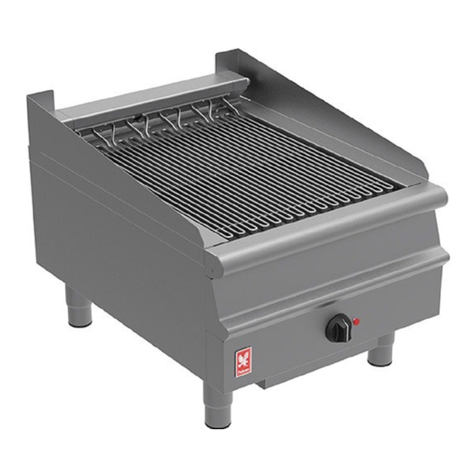
Falcon
Falcon Dominator Plus E3625 Installation and servicing instructions

HAEGER
HAEGER GR-240.015A User instructions
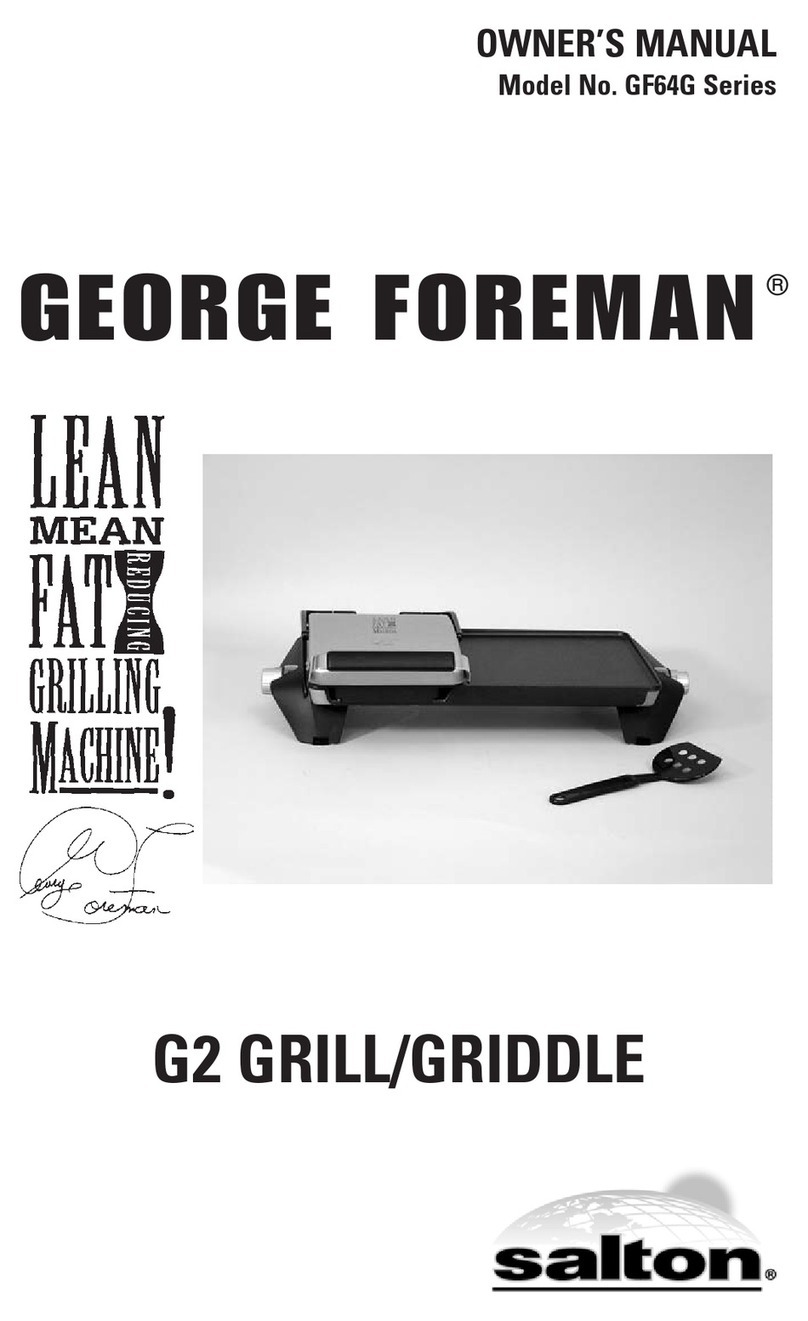
George Foreman
George Foreman GF64G Series owner's manual
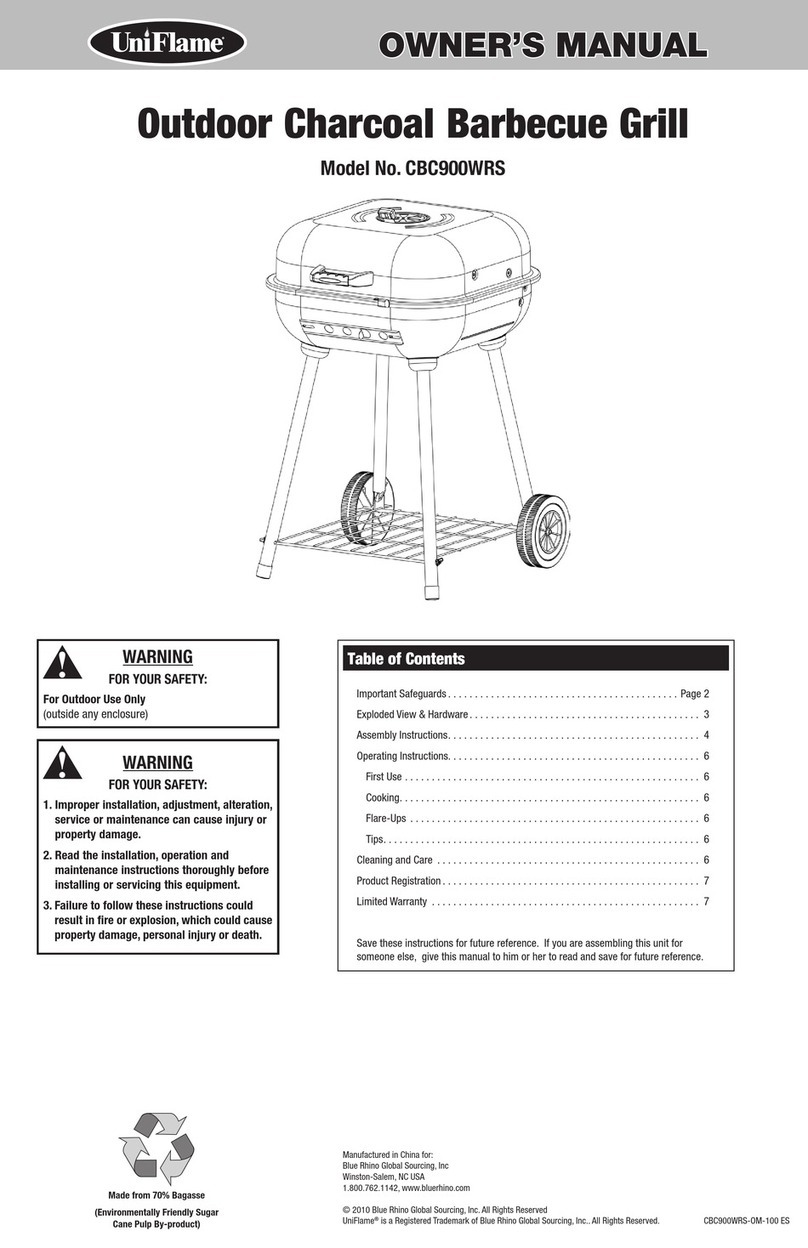
Uniflame
Uniflame CBC900WRS owner's manual

KitchenAid
KitchenAid KBGN274 Installation instructions and use and care guide

